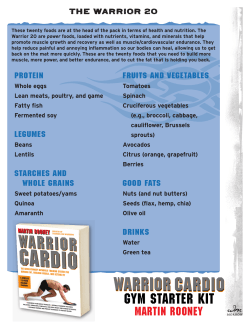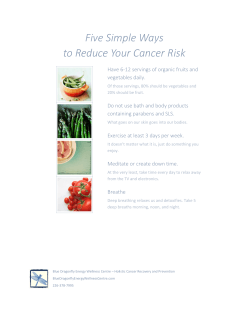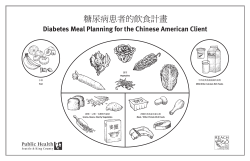
DEER: Four Nutrition Rules for Beginners
DEER Four Nutrition Rules for Beginners Written and Illustrated by Josh Mavilia Copyright © 2015 Josh Mavilia Disclaimer This document is for reference and informational purposes only and is in no way intended as medical counseling or medical advice. The information contained herein should not be used to treat, diagnose, or prevent any disease or medical condition without the advice of a qualified medical professional. The information contained herein has not been evaluated by a registered dietician. You should consult a physician or qualified medical professional before engaging in any of the activities, physical or otherwise, contained within this text. The author shall have neither liability nor responsibility to any person or entity with respect to any loss, damage, or injury caused or alleged to be caused directly or indirectly by the information contained in this book. For more information, please contact: Josh Mavilia at JoshMavilia.com T he Problem With Traditional Diets To paraphrase Alan Aragon (website here), “to create a fad diet, all you need to do is demonize a certain macro nutrient and write a book telling people not to eat it.” "Diet" isn't a bad word; we've just come to associate the word "diet" with temporary fixes, short-term solutions, and a frustrating lack of results. Low-fat. Low-carb. Sugar-free. Dairy-free. Grain-free. It's a wonder nobody's tried writing a low-protein diet book. When we decide to eliminate one entire category of food or macro, we eliminate all of the good things that come with consuming it. For instance, vitamins A, D, E, and K are all fat-soluble and deficiencies can occur with low fat intake or poor nutritional choices (Lichenstein & Van Horn, 1998). When we cut out carbohydrates, we lose the essential energy source that our brain needs to run, glucose. We’re likely going to feel nauseated and get headaches during our training because carbs are your primary energy source for intense activities. Furthermore, carbs are important for the regulation of many hormones like T3 (thyroid), testosterone, and insulin (all of which are helpful for maintaining muscle mass and keeping fat off). And here’s the thing, many people lose weight with these “macro-elimination” diets because it’s much easier to consume sub-maintenance calories when you cut out entire food groups. But eliminating entire macro groups doesn’t just impact our health, it also impacts our social life. Try eliminating fat from your diet and you’ve eliminated pizza, ice cream, fried foods, nuts, oils, avocado, coconut, chocolate, most dairy, and many varieties of animal (red, white, and fish). Or do the same thing with carbs. And now try to go to a restaurant with your family and friends. D EER What if I told you that you could add food to your diet and eat more, while still losing weight, maintaining or even building muscle, looking better, and gaining confidence ? That’s the theory behind DEER. The first three letters are all about adding things to your diet, not subtracting (and not eating actual deer, either). Changing your lifestyle and nutrition habits isn’t a punishment! The fourth letter is about using common sense to replace the average choices in our diet with outstanding ones. Despite all of the nutrition and exercise information out there right now, these are the first issues that I address with my own clientele. Every. Single. Time. These are the four steps that you must follow before you start counting calories, counting macros, or performing fasted cardio. Before you overcomplicate things, you must start with the smallest changes that will give you the biggest bang for your buck. All the fat burners, brand new Lululemon pants, and Extreme, Crazy, Intense, Exercise-5000 DVD’s in the world won’t help you if you aren’t following these four basic rules first. T he Rules 1. Drink more water The human body is approximately 65% water, give or take. It is vital to the transportation of nutrients throughout the body, controlling our internal temperature, and lubricating joints. Dehydration can cause headaches, tiredness, and decreased performance at the gym. Water is imperative to fatty acid metabolism (a.k.a. breaking down fat). It doesn’t matter if your calories, workout program, and sleep schedule are perfect, if you don’t drink any water. The general rule of thumb is half your bodyweight in ounces. But I prefer to take it a step further and recommend 100 ounces for everybody, every day. (For the record, one gallon is 128 oz.) (If you weigh over 200 lbs., just keep chugging those half-bodyweight ounces.) Whether your goal is weight loss, muscle gain, or performance enhancement, adequate water intake is crucial to your success. 2. Eat more protein Proteins are made of amino acids and amino acids are the building blocks of muscle. They are more thermogenic (it takes more energy to break them down) than carbs or fats and are usually pretty satiating. But proteins do more than just contract against force as part of our musculoskeletal system. Did you know that insulin and growth hormone are both proteins? So are enzymes (which catalyze reactions like fatty acid oxidation). Amino acids build much more than just muscle and play an important part in all of the body’s functions. There are even nine amino acids that cannot be synthesized by the body and must be ingested, such as leucine, isoleucine, and valine. Just like my recommendation of 100 ounces of water, I like to keep things simple and recommend 100 grams of protein per day. I call this my 100-100 challenge. While it’s not necessary to consume two or three hundred grams of protein per day to build muscle, consuming too little protein could be detrimental to overall body composition or performance. I boil protein selection down to three main sources: animals (as in the Green Face diet, if it had a face, it counts), dairy products (i.e. Greek yogurt and cottage cheese), and eggs. If you’re vegetarian or vegan, try to get protein from a variety of sources, as this will give you the best shot at consuming all of the essential amino acids. Between all of the animals in the world and all the different ways you can prepare eggs, these few sources have the potential to create months’ worth of different meals. 3. Eat more vegetables We know that vegetables contain vitamins, minerals, antioxidants, and other various phytochemicals. But vegetables are also extremely hard to overeat. Their calorie count is low and their volume is relatively high. For this reason, I recommend unlimited non-starchy vegetables with every meal. This could include things like broccoli, lettuce, kale, carrots, cucumbers, or green beans. Starchy vegetables include things like corn, potatoes, and peas (they’re much denser in carbohydrates and calories than their non-starchy brethren). To make things easy, if you might see it on a platter with vegetable dip it’s probably non-starchy (and easy to consume raw). But don’t eat unlimited vegetable dip with your unlimited non-starchy vegetables, that won’t contribute to any of your fitness goals. “Eat more vegetables” might even seem condescending, but let’s quickly recall the facts. As is the case with weight loss, reduced caloric intake generally means increased hunger hormones (which mean increased hunger). But stuffing ourselves with non-starchy vegetables gives us an opportunity to say no to calorically-dense foods like parmesan whipped mashed potatoes or quadruple chocolate mousse cake. And even if weight loss isn’t your goal, eating plenty of vegetables ensures that you’re consuming the right vitamins and minerals to support energy production, metabolic function, and hormone production, all of which are important to muscle growth and performance. 4. Replace the crap When I first created the acronym, I was unsure how the R would fit into my nutritional approach. However, I believe replace the crap has become the most important phrase in the DEER philosophy. And it’s largely related to identifying “clean” foods and removing the “dirty” ones. Crap can mean many different things to many different people. Here are some quick suggestions: ● ● ● ● Soy protein Trans fats Excessive omega-6 fatty acids Artificial sweeteners ● ● ● ● ● Excessive and frequent sugar intake Excessive caffeine Processed foods (i.e. beef jerky, deli meats, breakfast cereal, etc.) Excessive liquid calories Alcohol Soy protein is known to increase estrogen levels, even in males (Hamilton-Reeves et al., 2007). Items like trans-fats, omega-6 fatty acids, and sugars are all inflammatory and inflammation is widely considered to be one of the leading causes of chronic disease (Egger, 2012). Liquid calories (like protein shakes, milk, soda, and juice) are easy to over-consume, much the opposite of vegetables. Avoiding these allows us to remain fuller throughout the day, even if those liquids are dense with nutrients. And alcohol combines all of the issues of these other forms of crap: liquid calories, inflammation, and excessive carbohydrates. Replace the crap is more than just subtracting items from your diet; it’s about systematically making healthier choices. E xercise Like An Animal Your diet will determine your size; your training will determine your shape. Exercise is really easy. In fact, it might be the easiest part of the fitness equation. But you must combine exercise with nutrition, stress management, and sleep quality and optimize all four in order to achieve outstanding results. No matter whether you’re training for performance, muscle gain, or fat loss, training is generally built of the same components: Lift heavy Lift, sprint, and jump explosively Lift for reps The best fitness programs in the world always contain these three components. Strength and hypertrophy work are second-to-none at stimulating the release of hormones like testosterone and growth hormone, as well as creating a large disruption to homeostasis and a subsequent increase in the metabolism. For ideas, I recommend my Paleo Workout Plan. The basics include deadlifts, loaded carries, sled pushes and drags, presses, and sprints. I also have ideas listed under my articles on Tri-sets and Full-body Workouts. The illustration above shows my opinion on workout frequency. The black marks represent workouts (let’s put them at 12 pm, just for ease of interpretation). Each sketch depicts a different days-per-week structure and the subsequent increase in metabolism and protein synthesis that accompanies the workouts (I used 36 hours as the estimate for the length of the residual effects). As we can see, three and four day-per-week structures hold a clear advantage over only two days-perweek. Whether our goal is fat loss, muscle gain, or improved performance, adding an extra workout or two each week could pay big dividends over time! C ommon Questions What about intermittent fasting? Intermittent fasting is a structure where the individual contrasts periods of fasting with periods of eating. Short-term fasts can be anywhere from 12 to 20 hours, whereas long-term fasts typically last between one and two days. Fasting is only a dietary structure and doesn’t actually give any advice on type or amount of food eaten. For this reason, IF diets don’t guarantee fat loss, muscle gain, or performance improvement. But intermittent fasts can have benefits and are definitely a feasible structural option. For starters, IF reduces the number of insulin spikes throughout the day while also relieving the digestive system of stress. Fasting is known to stimulate the release of growth hormone and the shorter eating-window can provide an easy opportunity for a reduced caloric intake, though the latter is not guaranteed. I personally like the use short-term fasts to avoid blood sugar spikes and subsequent drops, helping keep my energy high through the fast. Short-term fasts are commonly performed through breakfast and during the morning hours, preventing blood sugar crashes during work What about exercising and eating for fat loss versus muscle gain? Whether you’re carrying footballs, carrying cats out of burning buildings, or carrying your groceries inside, we all train and diet for the same reasons: to look better, feel better, and perform better. Muscle gain comes from lifting weights, eating plenty of food, and recovering from your workouts. But did you know that fat loss comes largely from the energy expended during that very same recovery process? Therefore, our diets and training programs should look pretty similar! But if you’re looking to individualize, try these ideas: . For fat loss, toss in an extra day of conditioning or extra “finishers” at the end of your workouts. Split your training up into either full-body workouts or an upper/lower body part-split, whichever keeps you motivated. Have a trainer perform a Functional Movement Screen or a postural assessment for you and individualize your warm-up and corrective exercises. What about supplements? Supplements are just that: supplementary. They are meant to be added to an already cohesive diet as insurance. They are not necessary and it is completely up to an individual as to whether you want to add supplements to their diet. Common supplements include: ● ● ● ● ● ● ● ● ● Multivitamins Fish oil/omega-3s Vitamin D Vitamin C Iron Calcium Greens powders Protein powders Pre-workouts And the list goes on. If you’re thinking about taking any supplements, I’d strongly recommend using family, friends, books, coaches, and the internet for information. Try examine.com, there’s lots of info there. What about total calories? Overall calories matter most, no questions asked and there are many equations to calculate daily caloric needs. However, it can be difficult (if not altogether impossible) to estimate our actual caloric intake, the thermic effect of food, exercise-associated thermogenesis, non-exercise activity thermogenesis, or exact lean body mass. Furthermore, fat loss is decided by a consistent sub-maintenance calorie intake over time, not just short-term. For this reason, it’s may be more prudent to start with a consistent meal structure & food intake and then apply the “how’s that working for you?” test. What about cardio? Isn’t cardio better for fat loss? No (Mekary, 2014). In my opinion, weight training is actually more efficient at sculpting your body because of its ability to raise the metabolism immediately post-workout and for 24-48 hours afterward. What about daily meal structure? The most common daily meal structure involves breakfast, lunch, and dinner. In this case, you would simply break up your protein (100+ grams) between your three meals, drinking water at every meal and throughout the day. The same rule applies to greater than three meals. Split up your protein evenly and round your meals out with carbohydrates, healthy fats, and vegetables. In the case that you’re sedentary, avoid carbohydrate-dense foods altogether. These foods can include starchy vegetables like potatoes or yams and grains like rice, oats, and wheat-based foods. (Hint: this also includes plain ol’ sugar.) Don’t worry, you’ll get all the carbs your body needs from vegetables! Here’s a good starting point: 1. Pick your number of meals (for this exercise, don’t include snacks) 2. Each meal, use a plate about 8-10” in diameter (you don’t need to measure it, just make sure it’s not the size of your car tires) 3. Use a glass of any size, but 12-20 works well. Fill it with water. 4. If you’re sedentary, fill the plate with 1/3 protein (from the sources I listed above) and 2/3 non-starchy vegetables. Use healthy fats like avocado or olive oil as condiments, but do not reserve a place for them on your plate. 5. If you’re lifting, sprinting, and wrestling bears in your spare time, feel free to fill your plate with 1/3 protein, 1/3 non-starchy vegetables, and 1/3 grains and starchy carbs. 6. Consume all of the food and water in front of you or until satisfied (not stuffed). Refill your plate and glass as necessary. 7. Apply the “how’s that working for you?” test. What about snacks? Use snacks to get extra servings of protein and vegetables. Generally, we snack because we’re hungry between meals and protein and vegetables are much more likely to fill us up compared to almonds or vending machine candy. What about my kidneys? Can I eat too much protein? No (Manninen, 2005). What about peanut butter? Does peanut butter count as protein? No. Peanut butter is nearly ¾ fat (65-75%). What about cheat meals? I don’t believe in planned cheat meals because unplanned cheat meals throw that system off. Use the flow chart on the previous page to make your food choices. If you’re at a family function and the only food available is going to be a deli platter and meatballs, don’t stress about it and eat better at your next meal. You don’t need to bring a shaker bottle of protein powder with you. But if you’re at home, there’s no excuse when you choose snack cakes over chicken. What about big, bulky muscles? Won’t weight training make me huge? No. Muscle hypertrophy is dependent on a many factors (intensity, volume, etc.), but one major factor is hormone production. Females have less of the hormones (e.g. testosterone) that control protein metabolism and, thus, overall hypertrophy. You also need bricks to build a house. If you’re eating sub-maintenance calories, your muscles simply aren’t going to grow. References 1. Egger, G. (2012). In Search of a Germ Theory Equivalent for Chronic Disease. Preventing Chronic Disease, 9:110301. DOI: http://dx.doi.org/10.5888/pcd9.110301 2. Hamilton-Reeves, J. M., Rebello, S. A., Thomas, W., Slaton, J. W., & Kurzer, M. S. (2007). Soy Protein Isolate Increases Urinary Estrogens and the Ratio of 2:16α-Hydroxyestrone in Men at High Risk of Prostate Cancer. American Society of Nutrition, 137.Retreived from http://jn.nutrition.org/content/137/10/2258.long 3. Lichenstein, A. H. & Van Horn, L. (1998). Very Low Fat Diets. Circulation, 98, 935-939. doi: 10.1161/01 4. Manninen, A. H. (2005). High-protein diets are not hazardous for the healthy kidneys. Nephrology Dialysis Transplantation, 20. doi: 10.1093 5. Mekary, R., Grontved, A., Despres, J.P., De Moura, L.P., Azgarzadeh, M., Willett, W.C., Rimm, E.B., Giovanucci, E., & Hu, F.B. (2014). Weight training, aerobic physical activities, and long-term waist circumference change in men. Obesity, 23, 461-7. doi: 10.1002/oby.20949
© Copyright 2025









